-

新人教版高中英语必修1Unit 5 Languages Around the World-Reading and Thinking教案
【教材分析】本节课是高中英语第一册的最后一个单元的阅读和思考部分,文章难度明显增加,体现在以下几个方面:文章题材是说明文,比较难理解;话题生疏,涉及到历史等知识;生词量增大,而且在语境中理解词汇的要求提高。面对这些,教师的难度和高度也要有所提升,通过探讨说明顺序,了解背景知识等帮助他们找到说明文阅读的方法。【教学目标与核心素养】1. 文化意识目标新课程中指出,文化意识是对中外文化的理解和对优秀文化的认同。文化意识的的培养有助于学生增加国家认同和家国情怀,成为有文明素养和社会责任感的人。我们这个单元很好体现了这一点,通过了解汉字书写的体系和发展,学生可以有一种文化自豪感,同时也能够帮助学生深入挖掘这篇文章,从而想到更多和中国文化相关的方面。2. 学习能力目标

新人教版高中英语必修1Unit 5 Languages Around the World-Reading for Writing教案
Step 3: Read to sum upRead it again and sum up the problems of the three students, and then write down the advice that was given from others.Step 4: Work in pairs. List your learning problems in English and brainstorm some useful advice.Useful expressions ? I don't know how to…... Is a big difficulty for me. I cannot ...? You might try …. It's very important to…? I have no idea how/what .My biggest problem is .... ? I (also) have trouble with. My advice is …. This worked for me.? l cannot understand the teachers’ English in class.Step 5 Homework:为提高我校学生的英语口语水平,我们将举办英语演讲比赛(English- speaking contest),请你根据下面的信息,以学生会(the Students‘ Union)的名义写一份海报,欢迎全校同学参加,届时特邀本校美籍教师史密斯先生颁奖。? 报名时间 9月30日以前(报名:signup)? 报名地点 学生会办公室? 比赛时间 10月9日晚7:00~9:00? 比赛地点 学校大会议室? 奖励 前8名
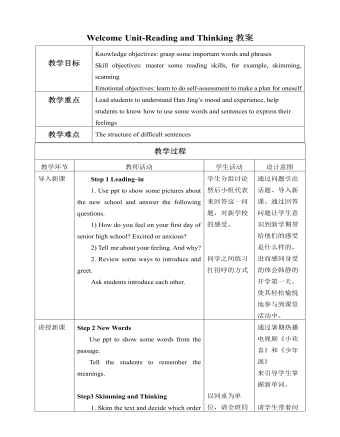
新人教版高中英语必修1Welcome Unit-Reading and Thinking教案
Step 2 New WordsUse ppt to show some words from the passage.Tell the students to remember the meanings.Step3 Skimming and Thinking1. Skim the text and decide which order Han Jing follows to talk about her first day. Time order or place order?Time order2. What is Han Jing worried about before she goes to senior high school?She is worried about whether she will make new friends and if no one talks to her, what she should do.Step 4 Fast Reading1. Match the main ideas with each paragraphParagraph 1:The worries about the new school day Paragraph 2Han Jing’s first maths classParagraph 3Han Jing’s first chemistry classParagraph 4Han Jing’s feelings about her first senior school dayStep 5 Careful Reading1. Fill in the chart with the words and phrases about Han Jing’s day. Answers: Senior high school, a little nervous; Her first maths class, classmates and teachers, friendly and helpful; Chemistry lab; new; great; annoying guy; Confident; a lot to explore2. Read the text again and discuss the questions.1) Why did Han Jing feel anxious before school?Because she was a new senior high student and she was not outgoing. What was more, she was worried about whether she can make friends.2) How was her first maths class?It was difficult but the teacher was kind and friendly. 3) What happened in the chemistry class? What would you do if this happened to you? A guy next to Han Jing tried to talk with her and she couldn’t concentrate on the experiment.
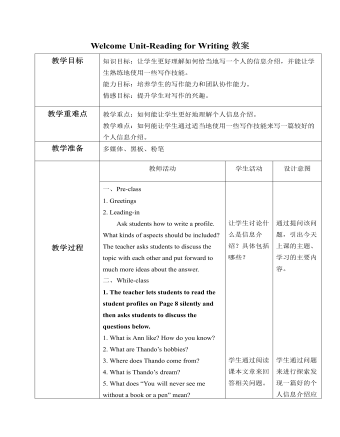
新人教版高中英语必修1Welcome Unit-Reading for Writing教案
教学目标知识目标:让学生更好理解如何恰当地写一个人的信息介绍,并能让学生熟练地使用一些写作技能。能力目标:培养学生的写作能力和团队协作能力。情感目标:提升学生对写作的兴趣。教学重难点 教学重点:如何能让学生更好地理解个人信息介绍。教学难点:如何能让学生通过适当地使用一些写作技能来写一篇较好的个人信息介绍。教学准备 多媒体、黑板、粉笔一、Pre-class1. Greetings2. Leading-inAsk students how to write a profile. What kinds of aspects should be included? The teacher asks students to discuss the topic with each other and put forward to much more ideas about the answer.二、While-class1. The teacher lets students to read the student profiles on Page 8 silently and then asks students to discuss the questions below.1. What is Ann like? How do you know?2. What are Thando’s hobbies?3. Where does Thando come from?4. What is Thando’s dream?5. What does “You will never see me without a book or a pen” mean?

新人教版高中英语必修2Unit 1 Cultural Heritage-Discovering Useful Structure教案二
This theme of the part is “ Describe people or things in greater detail”. Students have learned the grammar(restrictive relative clauses) in Book 1, and further review and consolidate its structure “prep+relative pronouns(which/whom)” and the relative adverbs(when, where and why), besides students should understand its form, meaning and functions. In this section, students should be able to express the grammar correctly in daily communication and in the writing. 1. Review the basic usages of relative pronouns and adverbs of attributive clauses . 2. Learn to use some special cases about restrictive relative clauses.3. Learn to write sentences with restrictive relative clauses flexibly according to the context.1. Review the basic usages of relative pronouns and adverbs of attributive clauses .2. Learn to use some special cases about restrictive relative clauses.3. Learn tow rite sentences with restrictive relative clauses flexibly according to the context.Step 1. Observe the following sentences, and mark the relative pronouns and the adverbs. 1. After listening to the scientists who had studied the problems, and citizens who lived near the dam, the government turned to the United Nations for help.2. Temples and other cultural sites were taken down piece by piece, and then moved and put back together again in a place where they were safe from the water.Step 2 PracticePlease complete these sentences with relative pronouns and relative adverbs and answer the following questions.Questions: 1. What is the head noun ?2. What relative words should be used ?3. What elements do they act in these sentences ?

新人教版高中英语必修2Unit 1 Cultural Heritage-Discovering Useful Structure教案一
This teaching period mainly deals with grammar “restrictive relative clauses.” To begin with, teachers should lead students to revise what they have learned about the relative pronouns and relative adverbs. And then, teachers move on to stress more special cases concerning this grammar, such as the “preposition+ relative pronouns which and whom” and cases where we can omit the relative pronouns. This period carries considerable significance to the cultivation of students’ writing competence and lays a solid foundation for the basic appreciation of language beauty. The teacher is expected to enable students to master this period thoroughly and consolidate the knowledge by doing some exercises. 1. Guide students to review the basic usages of relative pronouns and adverbs of attributive clauses.2. Lead students to learn to use some special cases concerning restrictive relative clauses flexibly.2. Enable students to use the basic phrases structures flexibly.3. Strengthen students’ great interest in grammar learning.1. Help students to appreciate the function of relative pronouns and adverbs of attributive clauses in a sentence2. Instruct students to write essays using the proper relative pronouns and adverbs of attributive clauses.本节语法思考:定语从句在复合句中的作用是什么? 关系词有哪些?定语从句在复合句中的作用相当于形容词,它在句中作定语修饰名词或代词。他们在先行词和定语从句之间起到联系作用,同时在意义上代表先行词并在定语从句中担任一个成分。被定语从句所修饰的词称先行词,定语从句一般放在先行词的后面。

新人教版高中英语必修2Unit 1 Cultural Heritage-Listening&Speaking&Talking教案
Listening and Speaking introduces the topic of “Take part in a youth project”. The listening text is an interview about an international youth cultural heritage protection project. More than 20 high school students from seven countries participated in the project. The reporter interviewed two participants Stephanie and Liu Bin. By listening to the text, students can understand the significance of cultural heritage protection, and teenagers can use their knowledge, combine their own interests and advantages, etc. to participate in the action of cultural heritage protection. Listening and Talking introduces the theme of "Talk about history and culture". The listening text is a dialogue between two tourists and tour guides when they visit the Kremlin, red square and surrounding buildings. The dialogue focuses on the functional items of "starting a conversation", which is used to politely and appropriately attract the attention of the others, so as to smoothly start a conversation or start a new topic. The purpose of this section is to guide students to understand the history and current situation of Chinese and foreign cultural heritage in their own tourism experiences or from other people's tourism experiences, explore the historical and cultural values, and be able to express accurately and appropriately in oral communication.1. Guide students to understand the content of listening texts in terms of the whole and key details; 2. Cultivate students' ability to guess the meaning of words in listening; discuss with their peers how to participate in cultural heritage protection activities.3. Instruct students to use functional sentences of the dialogue such as “I beg your pardon, but…” “Forgive me for asking, but…" and so on to start the conversation more politely and appropriately.

新人教版高中英语必修2Unit 1 Cultural Heritage-Reading and Thinking教案二
1. This section focuses on "Understanding how a problem was solved”, which is aimed to guide students to analyze and discuss the challenges and problems faced by cultural heritage protection during the construction of Aswan Dam, as well as the solutions. On the basis of understanding, students should pay attention to the key role of international cooperation in solving problems, and attach importance to the balance and coordination between cultural heritage protection and social and economic development. Students are encouraged to face challenges actively, be good at cooperation, and make continuous efforts to find reasonable ways and means to solve problems.2. Enable students to understand the main information and text structure of the reading text;3. Motivate students to use the reading strategy "make a timeline" according to the appropriate text genre;4. Enable students to understand how a problem was solved;5. Enable students to understand the value of protecting cultural heritage by teamwork and global community;1. Guide students to pay attention to reading strategies, such as prediction, self-questioning and scanning.2. Help students sort out the topic language about protecting cultural relics and understand the narrative characteristics of "time-event" in illustrative style3. Lead students to understand the value of protecting cultural heritage by teamwork and global community;

新人教版高中英语必修2Unit 1 Cultural Heritage-Reading and Thinking教案一
The theme of the reading and thinking is about “Understanding how a problem was solved”.The Listening & Speaking & Talking is about international co-work to protect the Mount Tai, in which the students from seven countries came up with many solutions even create the Mount Tai App. This section aims at showing how to solve a difficult and even tough problem about protecting the cultural heritage by the international co-work. So in this section, cultivating students’ international awareness is very clear and important. Concretely, with the economic development, how to balance the protection of cultural relics and social development is a big challenge for human. In the 1950s, the Egyptian government wanted to build the Aswan Dam across the Nile to control floods, produce electricity and water farms. But the proposal led to protests because it would destroy a lot of cultural relics. The Egyptian had no choice but ask the UN for help. Therefore, a international cooperation about how to protect the cultural relics began, which involved the time length about 20 years and a large amount of fund. Then, the problems was solved. 1. Read quickly to get the main idea and the structure of the article; read careful to get detailed information.2. Learn to use the reading strategy---making a timeline3. Learn how to solve a tough problem by asking for help and cooperation4. Have the international awareness and understand the great strength of international cooperation.1. Read quickly to get the main idea and the structure of the article; read careful to get detailed information.2. Learn to use the reading strategy---making a timeline.3. Learn how to solve a tough problem by asking for help and cooperation.

新人教版高中英语必修2Unit 1 Cultural Heritage-Reading For Writing教案
This report is short, concise and has typical news content and language features. The title uses the verb phrases, embodying the characteristics of being concise and general. The introduction is the first two sentences in the first paragraph, describing the general situation of the cultural heritage protection project, including time, place, characters, events and other news elements, so that readers can see the main points of the news report at a glance. The main body is the second and third paragraphs, which report the important historical and cultural value of Mogao Grottoes and the production of Mogao Grottoes Material digital photos, which are of great significance to the inheritance of historical culture and the promotion of international cultural understanding, exchange and cooperation. Direct citation is used in the report, as well as background introduction and other news writing techniques.1. Get students to have a good understanding of some features about a news report by reading the text.2. Instruct students to write a summary about a news report properly using some newly acquired writing skills in this period.3. Develop students’ writing and cooperating abilities.4. Strengthen students’ great interest in writing discourses.1. Stimulate students to have a good understanding of how to a summary about a news report 2. Cultivate students to write a news report properly and concisely.Step 1: Lead in Do you think it is necessary for us to circulate our cultural heritage to the world? Why or why not?Do we need to learn more about other countries’ cultural heritage? Why or why not?Step 2: Read to discover details concerning the main body of the news report.
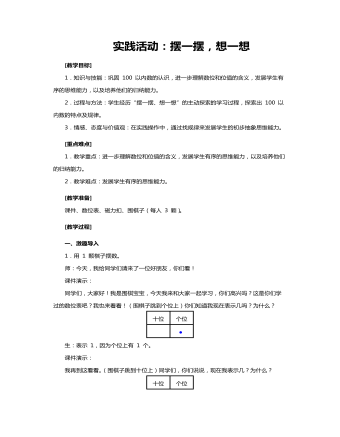
人教版一年级数学《实践活动摆一摆,想一想》教案
[教学目标]1.知识与技能:巩固 100 以内数的认识,进一步理解数位和位值的含义,发展学生有序的思维能力,以及培养他们的归纳能力。2.过程与方法:学生经历“摆一摆、想一想”的主动探索的学习过程,探索出100 以内数的特点及规律。3.情感、态度与价值观:在实践操作中,通过找规律来发展学生的初步抽象思维能力。[重点难点]1.教学重点:进一步理解数位和位值的含义,发展学生有序的思维能力,以及培养他们的归纳能力。2.教学难点:发展学生有序的思维能力。[教学准备] 课件、数位表、磁力扣、围棋子(每人3 颗)。[教学过程]一、激趣导入1.用 1 颗棋子摆数。师:今天,我给同学们请来了一位好朋友,你们看!课件演示:同学们,大家好!我是围棋宝宝,今天我来和大家一起学习,你们高兴吗?这是你们学过的数位表吧?我也来看看!(围棋子跳到个位上)你们知道我现在表示几吗?为什么?生:表示 1,因为个位上有 1 个。
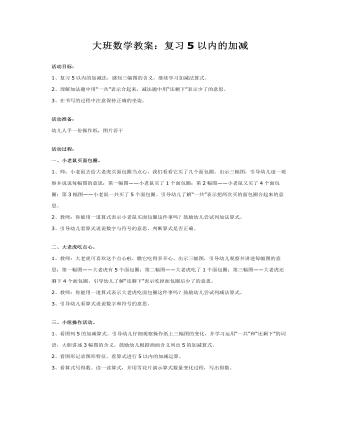
大班数学教案:复习5以内的加减
活动准备: 幼儿人手一份操作纸,图片若干 活动过程: 一、小老鼠买面包圈。 1、师:小老鼠去给大老虎买面包圈当点心,我们看看它买了几个面包圈。出示三幅图,引导幼儿逐一观察并说说每幅图的意思:第一幅图——小老鼠买了1个面包圈;第2幅图——小老鼠又买了4个面包圈;第3幅图——小老鼠一共买了5个面包圈。引导幼儿了解“一共”表示把两次买的面包圈合起来的意思。 2、教师:你能用一道算式表示小老鼠买面包圈这件事吗?鼓励幼儿尝试列加法算式。 3、引导幼儿看算式说说数字与符号的意思,判断算式是否正确。 二、大老虎吃点心。 1、教师:大老虎可喜欢这个点心啦,瞧它吃得多开心。出示三幅图,引导幼儿观察并讲述每幅图的意思:第一幅图——大老虎有5个面包圈;第二幅图——大老虎吃了1个面包圈;第三幅图——大老虎还剩下4个面包圈。引导幼儿了解“还剩下”表示吃掉面包圈后少了的意思。 2、教师:你能用一道算式表示大老虎吃面包圈这件事吗?鼓励幼儿尝试列减法算式。 3、引导幼儿看算式说说数字和符号的意思。

人教版新课标小学数学四年级下册小数的大小比较说课稿
4、完成教科书第65页练习十的第6题。让学生根据每种商品在每家商店中的售价情况,选择便宜的买。要学生解释什么叫便宜。(就是这几个数中最小的数)5、完成教科书第65页练习十的第7题。先让学生独立完成后,教师讲评时得问学生是怎样比较这几个数的大小的?(比较几个小数的大小时,可采用排列的方法,将几个数竖着排下来,注意数位对齐,也就是小数点对齐,这样比较起来较快,又不容易产生错误)练习中我注重辅助差生掌握新知,并鼓励他们的点滴进步,让他们感受到功成的喜悦。在教学中我利用幻灯教学,有利于培养学生的智力和能力。借助幻灯直观、形象、感染力强,便于数形结合的特点,调动学生的主观能动作用,促进学生积极思维,使课堂教学节奏加快,从而年高课堂教学效率。
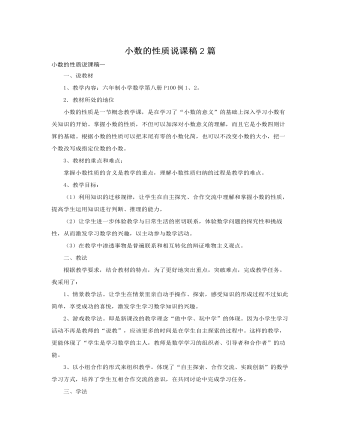
人教版新课标小学数学四年级下册小数的性质说课稿2篇
教师随着学生的回答用卡片拉出0.6000000…00[约有1.5米长],问:大小变了吗?[学生非常惊奇和振奋地说:没变!]如果它末尾的0像北京奥运圣火那样穿越五洲四海,它的大小变吗?[学生异口同声:不变!]也就是说与0.600大小相等的小数有多少个?师:在这无数个小数中,最简单的是哪一个?师:当我们遇到小数末尾有零,可以去掉末尾的零,写起来更简便,这就叫做小数的化简。(板书化简)说说是根据什么进行化简的?师:你能把0.40 1.850 2.900 0.080 12.000化简吗?请大家打开数学书59页做一做第一题,写在数学书上。【0.080】师:这个0为什么不去掉,去掉会怎么样?【12.000】师:运用小数的性质,我们可以把三位小数化简成整数。师:那你觉得在运用小数的性质化简小数的时候,应该注意什么?
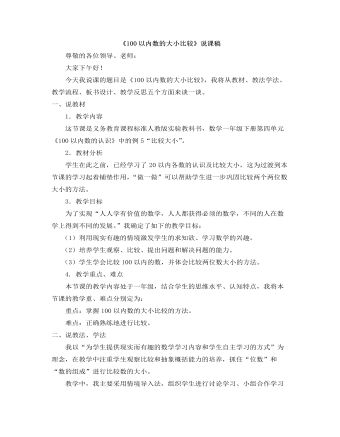
小学数学人教版一年级下册《100以内数的大小比较》说课稿
尊敬的各位领导、老师:大家下午好!今天我说课的题目是《100以内数的大小比较》,我将从教材、教法学法、教学流程、板书设计、教学反思五个方面来谈一谈。一、说教材1.教学内容这节课是义务教育课程标准人教版实验教科书,数学一年级下册第四单元《100以内数的认识》中的例5“比较大小”。2.教材分析学生在此之前,已经学习了20以内各数的认识及比较大小,这为过渡到本节课的学习起着铺垫作用,“做一做”可以帮助学生进一步巩固比较两个两位数大小的方法。3.教学目标为了实现“人人学有价值的数学,人人都获得必须的数学,不同的人在数学上得到不同的发展。”我确定了如下的教学目标:(1)利用现实有趣的情境激发学生的求知欲、学习数学的兴趣。(2)培养学生观察、比较、提出问题和解决问题的能力。
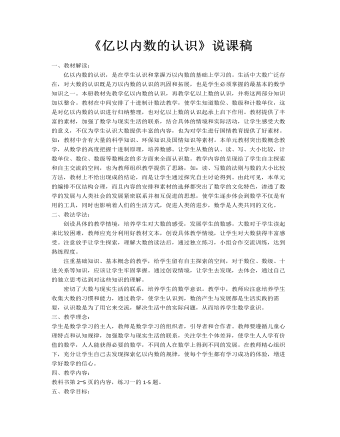
小学数学人教版四年级上册《亿以内数的认识》说课稿
三、教学理念:学生是数学学习的主人,教师是数学学习的组织者,引导者和合作者。教师要遵循儿童心理特点和认知规律,加强数学与现实生活的联系,关注学生个体差异,使学生人人学有价值的数学,人人能获得必要的数学,不同的人在数学上得到不同的发展。在教师精心组织下,充分让学生自己去发现探索亿以内数的规律,使每个学生都有学习成功的体验,增进学好数学的信心。四、教学内容:教科书第2~5页的内容,练习一的1-5题。五、教学目标:1.使学生认识计数单位"万""十万""百万""千万"和"亿",知道亿是个大数;知道亿以内各计数单位的名称和相邻两个单位之间的十进关系。2.掌握数位顺序,理解并掌握我国四位一级的计数习惯,能够根据数级正确地读出亿以内的数。3.通过情境创设,小组合作学习等形式,使学生获得正确读数的成功体验;培养学生分析、综合的能力。4.培养学生对大数的感受,发展学生的数感。六、教学重点:亿以内数的认识,读法。七、教学难点:1. 数级、数位、计数单位的区别以及"位值"的理解。2.每级中间或末尾有0的读法。八、教具学具:教师准备PPT课件,数位表,师生都备计数器。
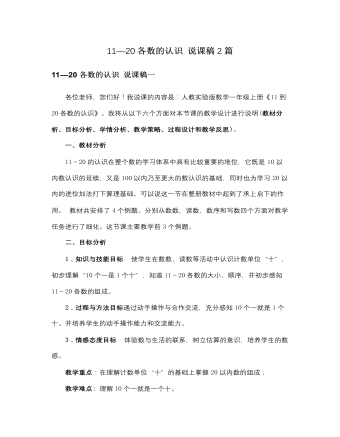
人教版新课标小学数学一年级上册11—20各数的认识 说课稿2篇
(二)自主探究,学习新知。(1)认识“11”。让学生说说身边的“11”,接着数出11根小棒。根据学生已有的知识和经验,猜想学生能顺利地数出;再接着让学生另外数出11根小棒,动手摆一摆,探讨一下还有没有别的更好的摆法。比较各种摆法的不同点。[在学习新知,突破重难点这一环节,让学生动口说一说,动手摆一摆,用眼观察,用脑思考,使学生通过具体实物比较各种摆法,让学生借助实物感知10根一捆的原因,建立以一代十的表象认知。](2)学习例2中的“15、20”,加深理解组成。让学生数出15根小棒,动手摆一摆,捆一捆。引导学生运用上面发现的容易看出数量的方法,摆一摆,捆一捆,同桌交流,互相猜猜,根据实物说出数量,根据实物说数的组成,再倒过来根据组成说出这个数。如:“15是由1个十和5个一组成,1个十和5个一组成15。”同样,让学生动手摆摆,捆捆,看看,说说,学习“20”。
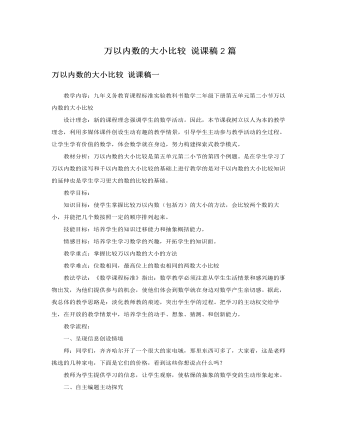
人教版新课标小学数学二年级下册万以内数的大小比较说课稿2篇
(四)、课堂小结:1.提出问题:请谈一谈这节课你有哪些收获?2.你觉得这节课自己表现怎么样?谁表现得最好?请你评一评。(进一步引导学生对比较数的大小的方法进行归纳、总结,从而使学生完成知识的构建。让学生对自己和同伴做出评价,以利于学生今后的成长。)总之,本节课的设计力图体现新课程的理念,以促进学生的发展为宗旨,充分体现了学生学习的自主性,相信学生的能力,挖掘学生的各项能力,,激发学生学习数学的兴趣,增强数学学习的信心,体会数学与生活的联系。七、说教学反思在二年级下册《万以内数的认识》单元中,学生已经掌握了“千以内数的大小比较”的方法,“万以内数的大小比较”只需在此基础上完成知识的顺迁移即可。因此,在本堂课的教学设计中我并不急着把“比较数的大小”的方法教给学生,而是把重点放在了学生对大小比较的真正理解上,通过本节课的学习能用自己的方法解决实际问题。
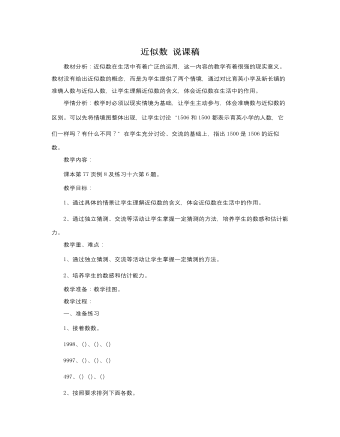
人教版新课标小学数学二年级下册近似数说课稿
1、组织理解近似数的含义。出示例8的主题图。聪聪去调查了育英小学的学生数,他写下了这样的一句话:“育英小学有1506人,约是1500人。”育英小学到底有1506人还是1500人呢?为什么?组织学生进行讨论、交流。思考:后半句约1500人是什么意思?小组汇报:A、认为育英小学的认数是1506人,因为他告诉我们就是1506人,后半句他说的是约是1500人,是说他们学校的人数和1500人的差不多。B、也认为育英小学有1506人,他说约有1500人是大概就是1500人的意思。师小结:我们把1506这个很准确的数字就叫做“准确数”,而1500这个和1506差不多的数就叫做“近似数”。(边说边板书)引导学生明白近似数更容易记,因为它正好是正百数。出示例8主题图比较一下1506和1500这两个数,体会一下准确数和近似数哪个数更容易记住
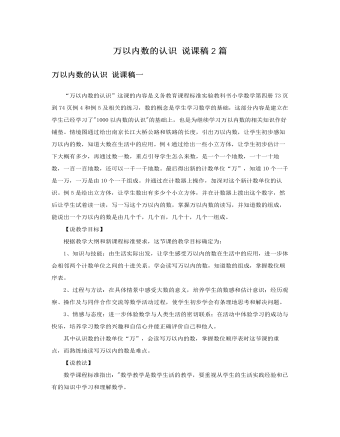
人教版新课标小学数学二年级下册万以内数的认识说课稿2篇
【说教学目标】根据教学大纲和新课程标准要求,这节课的教学目标确定为:1、知识与技能:由生活实际出发,让学生感受万以内的数在生活中的应用,进一步体会相邻两个计数单位之间的十进关系。学会读写万以内的数,知道数的组成,掌握数位顺序表。2、过程与方法:在具体情景中感受大数的意义,培养学生的数感和估计意识;经历观察、操作及与同伴合作交流等数学活动过程,使学生初步学会有条理地思考和解决问题。3、情感与态度:进一步体验数学与人类生活的密切联系;在活动中体验学习的成功与快乐,培养学习数学的兴趣和自信心并能正确评价自己和他人。其中认识数的计数单位“万”,会读写万以内的数,掌握数位顺序表时这节课的重点,而熟练地读写万以内的数是难点。

